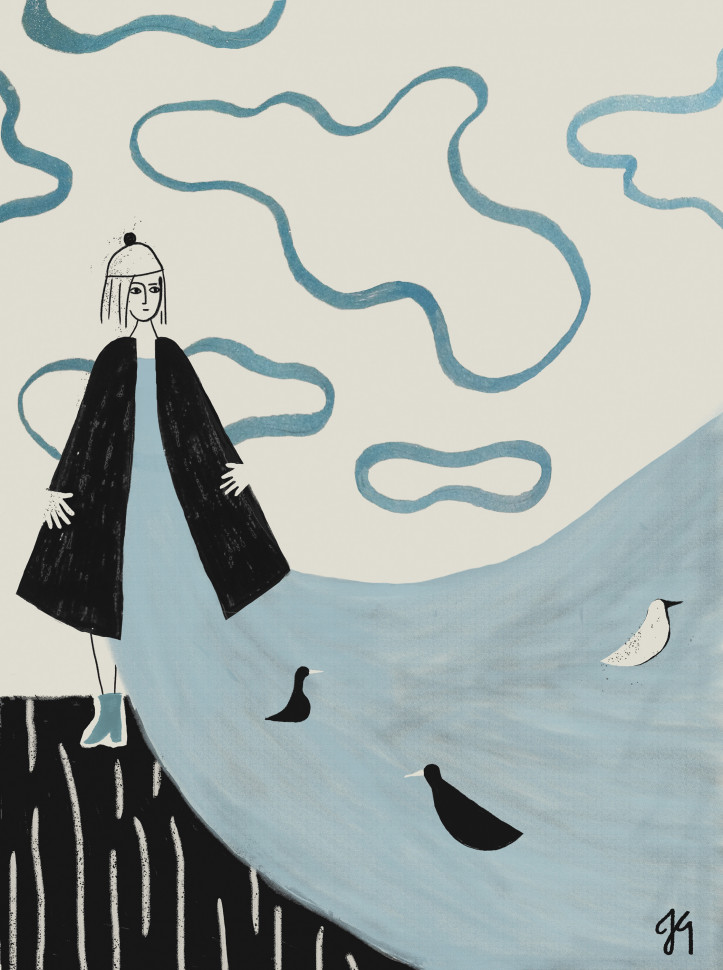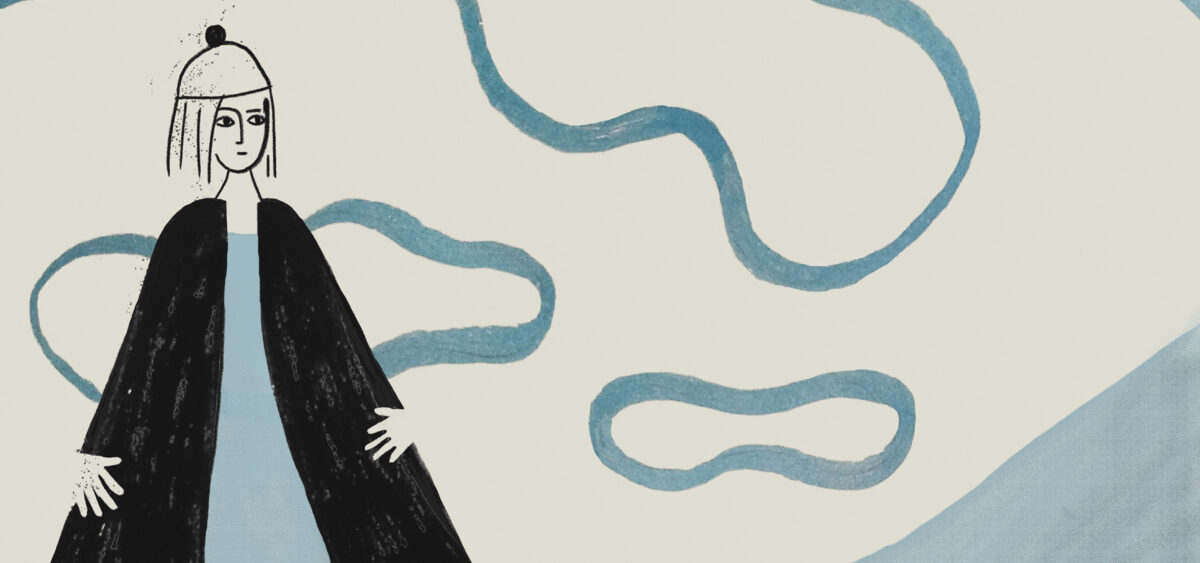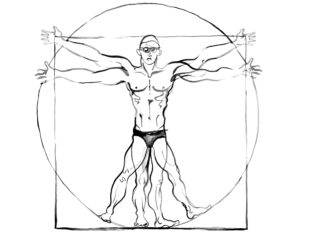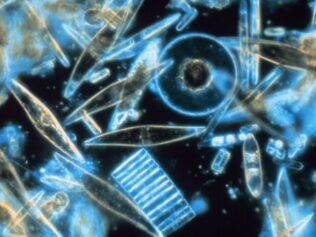
Go out, find a forest, sit in a clearing, look around. What do you see? Water, water everywhere.
Behind me, a forest. The dark walk, it grows almost audibly, gets entangled and stuck with new layers of plants, tendrils, deaths, tracks. It is the end of May, apart from all of this the forest attacks me with smells. If I had sat here a fortnight earlier, it would have smelled of wild garlic, wet and sharp like freshly washed chives. Yet wild garlic is gone, its leaves now lie at the bottom of the forest, a carpet of dead tissue growing yellow. In this slimy, yellowish rotting, wild garlic does not die. Its leaves have been amputated, they are not needed anymore. Caressed by the rain of sunny photons, their chloroplasts have produced enough life-giving sugars for the plants to bloom, to fructify before the end of spring, before the canopy of the trees’ leaves cuts them off from the sun for the rest of the spring and summer. The garlic’s embryonic plants will one day try to grow from the seeds, and the garlic’s fathers-cum-mothers will fall asleep in their underground bulbs and wake up next year in the spring, fed with this sunny sugar. There is no more smell of garlic in the woods. Now you can smell the May lily of the valley, it comes at you in lazy waves, wafting to the wet meadow where I’m sitting. Perfumed with the heavy fragrance, the forest behind me is simpering and cosying up to me.
I sit like this every year, it is a part of my job. And every year I take these waves of forest fragrance in with the same – and genuine! – voracity. If I could, I would feed on these smells, forgetting about human food. This place – thrown in the very centre of the coast of the lazy Baltic Sea, forgotten by people and probably by time as well – is made of smells, but also of light, of water in all its states of matter, of strangely alien bird sounds. I am not gonna tell you where I am exactly just yet. Maybe I won’t tell you at all. I’m not sure I’d like to share these soft pieces of reality smelling of smoke, garlic, lily of the valley, honeysuckle and wet moss. As justification, I can only add that it’s not me who’s enviously guarding this secret – it is the secret that’s enviously guarding me. For about a dozen years, every year this place has led me to itself, every step of the way, through miles of land and water.
Cycles, circles and cogs
Today the meadow is particularly wet. It hasn’t rained for quite some time – it is one of these springs when the clouds hardly ever obscure the sun. And yet every morning the grass sparkles with dew drops, and a cold dampness creeps up the trouser legs and T-shirt. A few steps and you’re knee deep in the cool wetness, wading ever more grotesquely, like a crane. As if lifting your knees higher than usual and keeping your legs straight, like a pair of stilts, was to save you from the dampness. When I’ve reached the place where I’m going to sit down, I am completely soaked from the waist down. This is a totally astronomical soaking. You see, these trousers sticking to your skin and the water plopping in your shoes are the cosmic signs of where our planet is heading through the emptiness of the universe. An ordinary meadow – practically all mine at this very instant – is the centre of the universe. At dawn, the grass will probably be covered in a coat of hoarfrost, right now water drops – a multitude of lenses – swell on every leaf. All because in this particular place in the cosmos, on a chunk of rock circling a perfectly average star, in every moment it may so happen that water is a translucent, fluid lens with a microscopic copy of reality reflected inside – and a white, sharp crystal of ice and an invisible cloud of gas particles rushing in all directions at once.
Even though you can’t see it at first glance, sitting on the edge of this meadow, I’m actually sitting in an ocean of water. Meticulously packed in microscopic portions, strategically sent over pulsating highways, sometimes really defying the force of the all-powerful gravity, because why wouldn’t it be? Each of these little pellets has its own ways of using water, and each navigates this ocean and goes about its watery business – almost like it did four billion years ago when newborn life was stretching its molecules for the first time in the ocean of early Earth.
Sometimes I like to imagine what it would sound like, if the omnipresent water could produce sounds. Where I am now, the water is rarely so hasty and impatient to let itself be heard. There’s no brook that could be rippling between the rocks. There are no glaciers that, in the summer, amid noise and uproar, break off pieces of themselves and toss them into the sea, and in winter, they barely audibly hum and rumble, while gliding through the coarse rock. For a moment, then, I’m becoming the most sensitive of microphones. I eliminate from my field of vision the light of the golden morning just before noon, sparkling with swarms of insects – I want to hear water, the mythical cycle of this substance, as it sifts through the ecosystem and meshes with its lesser brothers, watery circles, blocks and tackles, down to the tiniest vortexes nudging the cells’ cellular organelles.
Two sides of the water sheet
First I can hear wet stomping, splats of feet as fine as a hair, which stir the still water surface. Behind me, the tiny forest pond – its sheet as smooth as glass and as dark as night. Water in its regular form – I dread to think how deep it is and what lends it its colour, since it adopts such an eerily gloomy hue. From time to time, the still sheet dissolves into a row of quickly moving wrinkles, as if the pond was having moments of deep reflection. These are water striders, so slender in their insect bodies, always lifted on their slim, trichoid legs. They occupy the world of the surface, they take possession of the sheet of the obsidian water, absolute masters of this two-dimensional place, with a monopoly on straddling the edge of living and death by drowning. For most insects, an encounter with the surface of the water can only end with death. But not for water striders. The two-dimensional reality is their element and any insect visiting from the three-dimensional chaos over the pond usually ends up as a water strider’s dinner.

Even if you look at the water strider closely, you will get to know the secrets of its monopoly only partially. Stuck to the still surface, the water strider creates this whole flat world for itself almost out of nothing. Around its trichoid legs, the sheet of water bends as if every leg was leaving a shiny trace in the invisible surface film. Thanks to surface tension, the force resulting from the intense attraction of liquid molecules to each other, the water strider is held in its slippery, vast micro-world, on the border of wetness and dryness. The same secret – but from the other side altogether – is known to the tenants of the black depths. Glued to the world of the shiny surface there is another world, an odd mirror reflection, of the world above, a slow universe submerged in the pond. The two flat universes probably have no idea that their backs lean against each other. In this other world, on the line of the same surface tension, hang mosquito larvae. Each of them, with a tiny straw growing from the back of their body every now and then disappears in the black depth to emerge after a while, tossing and bucking and kissing the water sheet from the other side. Each kiss is a deep breath, taking in the lily-scented air from above the water sheet, through the straw, straight into the larva’s little body. The pond then sounds like plopping stomps and kissy sighs, when the two worlds, connected, but light years apart, keep on living, making use of the same physical mystery.
The sundew’s sour leaf
I turn the antennae of my acoustic radar – in the maze of the inextricably tangled up grass, in the moisture of the dirty, wonderfully scented ground, something is bubbling loud. Plants are amazing. Me, you and the majority of vertebrae, who so boldly place themselves at the top of life’s ladder, can never equal their resourcefulness in matters of water. Had it not been for bones – these hard, crude, brutally unpoetic pieces of limestone debris – we would be nothing more than a piece of torn down curtain. A heap of fleshy moaning jelly. Plants adopted a different, wonderfully simple strategy. They developed a taste for dust and the land’s waterlessness much earlier than our animal ancestors – and it seems they kept their original ways in regard to keeping a proper shape. Their cells are little balloons, bulging with water and tucked in the corsets of their cell walls. Of course, in time, plants had to create their own skeletons, strips of dead wood, cords of hard lignin straightening their stems and drawing up their trunks higher and higher, in defiance of the force of gravity. Yet in essence a plant stands upright and proud thanks to water. It is the pressure of water that jostles within the cellulose walls of the boozed up cell that holds the leaves outspread, and the tiniest leaves of grass in the right position.
There, in the grass, a sundew gurgled, satisfied with itself. In a moment, it is going to stuff itself, right now she’s just started the process of swallowing, which takes about a dozen hours. The sundew eats insects. The whole process of eating is put into motion thanks to water. Tickled by the insect, the sundew’s leaf becomes an extremely slow killing machine. The leaf is covered in tiny red needles, soft hairs drooling with sticky liquid. The insect gets stuck to it – but it is just the beginning. Now the sundew, having been touched, starts transporting water from one place to another. It presses the juices from some cells to others; some cells swell at the pressure, others relax. It is a symphony of harmonious inebriation and withering, a wave of alternately overflowing with water and purposefully soaking. This way, the inflated parts of the leaf become siphons and at their own murderously slow pace fold the leaf like a crêpe with a still living, six-legged filling, kicking and screaming. The hairs’ little red needles shoot electricity, the cells at their bases suddenly start leaking and inundating the cells’ walls with proton soup. The environment in the walls becomes acidic and softens for a while, and the thus freed hairs close around the insect. Then a wave of digestive juices – once again, water – floods the insect while it’s catching its last breaths, and starts dissolving its body; unfortunately for the victim, the insect’s nervous system is still working for some more horrible moments. The water stops travelling, the leaf stops motionless and slowly licks from its surface the watered down insect juice.
Moss’s courtship
The forest behind my back is all water. In its stoic motionlessness, in the lignin-stiffened silence, it sips the soil’s dampness, through the root hair, it sucks in water in tiny gulps and sends it to the crown, where the water, with a sigh from the tiny leaf lips, is sent straight into the atmosphere. Or it flows into chloroplasts, where it stops being water, broken up by sunlight and electrons circling in these green pellets. It becomes oxygen. For the tree, a photosynthetic piece of garbage; for me, a life-giving gas, mixed with the scent of lily of the valley. Flowing up from the soil, through roots and up to tree crowns, water turns the forest into a constantly working water mains. Leaves oozing out water into the atmosphere, sucked out from the lower parts of the tree. There, the water crawls along microscopic pipes, dead cells where, thanks to the surface tension, it sticks to the cell walls and crawls higher and higher. In other words, water in a tree flows through a vertical necropolis – a cemetery of beautiful cells that the tree had to kill off in order to be able to peacefully swallow the solution coming from the soil.
In the boughs of one of the oaks, a celadon pillow of moss is growing in all directions. Moss is quiet, it doesn’t need any rippling water vessels, any tracheids pumping water into the leaves’ stomas. Moss is small and makes use of water with all its body, transporting it between its parts, simply soaking it in like thin, damp tissue paper. I love mosses, because apparently they have a very long and good memory. For instance, many of them are incorrigible traditionalists. While the majority of the terrestrial plant world learned a long time ago to take care of their sexual business prudishly in secret, away from the dirty and cold waters of this world, mosses prefer to make love in the shiny, slimy wetness. I can hear a drop of water taking off from a tall oak with a silent splash. It must have been hiding there since it rained two days ago, squeezed in the cracks of the not-yet-opened leaf bud. The drop falls at full speed on the pillows of moss where a soft and wet mossy sexual encounter begins. On the tops of their tiny stems, some of the mossy plants have little rust-coloured bowls – they are thirsty, wide open and impatient. There, tucked in tiny bottles, swarms of sperm are waiting anxiously. The oakey water drop falls into the bowl and splashes its particles all over, taking along the way swarms of sperm and tossing them onto other stems of moss where dozens and hundreds of egg cells are waiting. Totally old school. It doesn’t matter if it’s on dry land, far away from reservoirs – moss is having its plant sex in the smithereens of water, hungrily fertilizing anything the splattered drop of water can get ahold of. And now it’s done. Mitoses will take care of the rest: they will magically turn this wet moment into a box of dry spores, as light as a dream.
The drop is here
It is so stupid to treat water as mere solvent, a colourless background for all cellular reactions and biochemical thrusts. We take it for granted, our earthly and familiar water. We dream of cosmic waters, imagining dark oceans on Jupiter’s Europa and Callisto, of foaming sherbets of dust and water comets, or blocks of ice somewhere under the red sands of Mars. Yet it is enough to sit in the cold wet meadow, let ordinary water soak the capillaries of our socks and trousers, to breathe in the invisible, frivolous water vapour and focus on the wettest, dampest nooks of our nearest surroundings. To hear water in its tiniest portions. Me, for example, I will get up, take my shoes and socks off and touch the wet grass with my feet. My feet will be very cold. And ecstatically wet.
Translated from the Polish by Adam Zdrodowski










